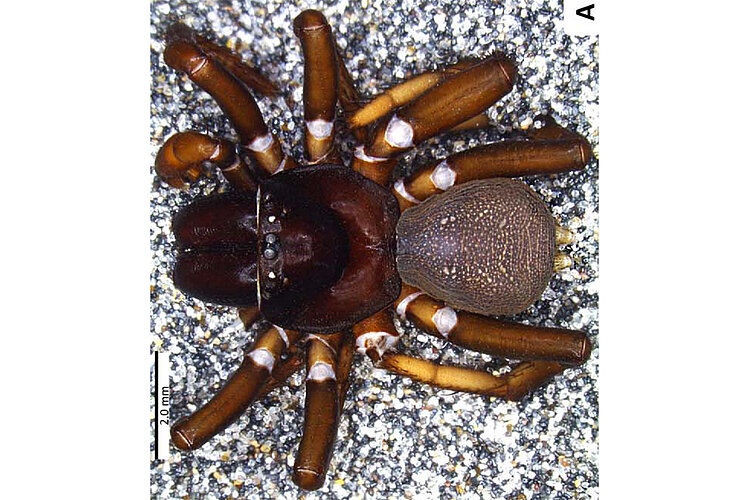Faulder's Mouse Spider Missulena faulderi Harms & Framenau, 2013
Fauna Portal species: 7629Diagnosis
(after Harms & Framenau 2013): Males of M. faulderi differ from all other Missulena from Australia by the very long and slightly curved embolus of the male bulb. They differ from other Missulena, except the most similar species M. rutraspina, by the presence of a pronounced rastellum, which is developed as a distinct process with three to five large conical spines rather than a series of narrow spines on a process or low mound. Missulena faulderi males (carapace length < 3.5) differ from the males of M. rutraspina (carapace length > 3.8) by the smaller size, the presence of an interior row of seven to eight fused teeth in the cheliceral furrow (teeth divided in M. rutraspina), the shape of the male bulb which has no depressions, and a medially curved embolus (bulb with spiral depression and embolus almost straight in M. rutraspina, see Faulder 1995). Missulena faulderi males do not have any red markings on the carapace and chelicerae (as do males of M. occatoria and M. langlandsi), do not have rasps on patellae I, II (similar to M. dipsaca, M. rutraspina & M. tussulina) and IV, and have lateral ridges on the chelicerae. Females of M. faulderi are unknown.
Status
- native
Linnean Holotype
Australia
- Western Australia
Fauna Portal Records
The map shows all records that have been verified as part of the Fauna Portal project and may not represent the true distribution of a species. Specifically, for described species, check the link to the Atlas of Living Australia on this page for potential wider distributions. Fauna Portal Reference specimens and Linnean types are shown in red. If you identified a specimen that exceeds the distribution of an undescribed species as illustrated here, please contact the Fauna Portal team who can assist with the lodgement of the specimen in a public institution and display on the map.
Similar Species
Publications
Framenau V.W. & Harms H. (2013): New species of Mouse Spiders (Araneae: Mygalomorphae: Actinopodidae: Missulena) from the Pilbara region, Western Australia. Zootaxa. 3637: 521 - 540
AAAGATATTGGAACTATATATTTAATTTTTGGTATTTGGTCAGCAATATTAGGGACAGCGATGAGAGTAATTATTCGAGTGGAATTAGGTCAGGTGGGGAGAATGTTAGGAGATGACCATTTGTATAATGTTGTAGTGACAGCTCATGCATTGGTAATGATTTTTTTTATAGTAATGCCTATTATAATTGGTGGGTTTGGAAATTGATTGATTCCTTTAATATTAGGGGTTCCTGATATAGCTTTTCCTCGTATGAATAATTTGAGTTTTTGGTTACTTCCTCCTTCTTTGTTTATGTTGTTGTTGTCATCTATAACAGGGAGAGGGGTAGGGGCGGGATGAACTATTTATCCTCCGTTGTCTTCAGGGTTAGGACACGGGGGGGGAGGGGTGGATTTTGCTATTTTTTCTTTACATTTAGCTGGGGCTTCATCTATTATAGGAGCGATTAATTTTATTTCAACTATTATAAATATACGGGTAGAGGGGATAACTATGGAGAAGGTTTCTTTATTTGTATGATCTGTATTGATTACGGCTATTTTGTTATTATTATCTTTACCAGTTTTAGCGGGAGCTATTACAATATTATTGACTGATCGTAATTTTAACACTACATTTTTTGATCCTGCTGGGGGGGGGGATCCCGTCTTGTTTCAGCATTTGTTCTGATTTTTTGGGCATCCTGAGGTGTATATTTTGATTTTACCAGGGTTTGGAATGATTTCTCATATTGTAAGAAGTTCGGTAGGGAAACGTGAACCTTTTGGGGCGTTAGGAATAATTTATGCTATGGCTGGAATTGGAGGGATAGGATTTGTTGTAT
Araneae (Spiders)
- Actinopodidae
- Anamidae
- Araneae fam. indet.
- Araneidae
- Archaeidae
- Argyronetidae
- Arkyidae
- Barychelidae
- Cheiracanthiidae
- Clubionidae
- Corinnidae
- Cycloctenidae
- Deinopidae
- Desidae
- Dictynidae
- Filistatidae
- Gnaphosidae
- Halonoproctidae
- Hersiliidae
- Idiopidae
- Lamponidae
- Linyphiidae
- Lycosidae
- Mimetidae
- Miturgidae
- Mysmenidae
- Nicodamidae
- Oecobiidae
- Oonopidae
- Oxyopidae
- Philodromidae
- Pholcidae
- Pisauridae
- Prodidomidae
- Salticidae
- Scytodidae
- Segestriidae
- Selenopidae
- Sparassidae
- Symphytognathidae
- Tetrablemmidae
- Tetragnathidae
- Theridiidae
- Thomisidae
- Trachelidae
- Trachycosmidae
- Trochanteriidae
- Uloboridae
- Zodariidae
- Zoropsidae
All classes
- Arachnida
- Crustacea
- Entognatha
- Gastropoda
- Insecta
- Orthoptera - Caelifera (Grasshoppers)
- Hymenoptera excl. Formicidae (bees and wasps)
- Blattodea s. str. (Cockroaches)
- Coleoptera (Beetles)
- Dermaptera (earwigs)
- Diptera (flies, mosquitos)
- Entomobryomorpha (slender springtails)
- Hemiptera - Heteroptera (True Bugs)
- Hemiptera - Sternorrhyncha (aphids, scales etc.)
- Hemiptera - Auchenorrhyncha (cicadas, planthoppers)
- Hymenoptera - Formicidae (Ants)
- Trichoptera (Caddisflies)
- Zygentoma (silverfish)
- Myriapoda

